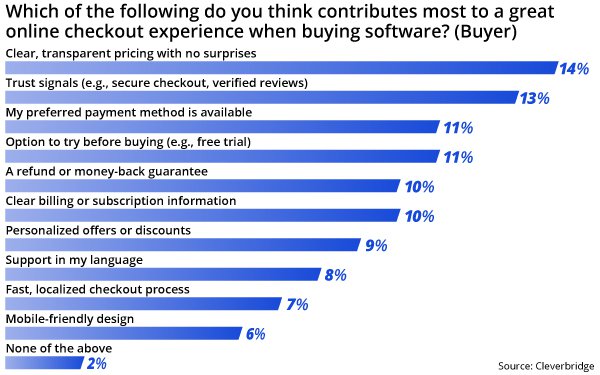
The software
business is now almost totally online. But that leads to problems like cart abandonment, judging by a two-part study from Cleverbridge, conducted by Ascend2.
Of the
software vendors surveyed, 98% now sell online, and over 50% generate the majority of their revenue through ecommerce.
But while 83% of sellers plan to
expand internationally in the next 12 months, only 6% say they are doing so with ease.
Moreover, 82% of vendors are suffering from double-digit rates of
cart abandonment and nearly 50% are losing at least 25% of prospective orders to a "friction tax.”
Sellers point to the issues of too many steps (39%), payment method not available (36%)
and unexpected taxes/fees (35).
advertisement
advertisement
For buyers, the order is different. They blame cart abandonment on unexpected taxes/fees (48%), payment method not available (31%) and too
many steps (30%).
What brings a buyer back after cart abandonment? They cite:
- Discount or offer — 43%
- Increased trust in the site — 40%
- Better understanding of the product — 37%
- Easier checkout —
35%
- Reminder email or message — 22%
- Nothing-usually don’t come back —
12%
Once the purchase is made, software buyers expect the following:
- Easy access to manage or cancel the subscription
— 49%
- Clear billing and received information — 48%
- Prompt customer support —
42%
- Refund or money-back guarantee — 40%
- Confirmation emails and receipts — 39%
- Set-up help or onboarding — 30%
- None of these are important — 2%
However, sellers cite these
challenges in retaining and growing revenue from existing customers:
- Maintaining consistent communication with customers across segments (e.g., product updates,
usage tips, etc.) — 35%
- Ensuring tax and compliance accuracy for renewals and cross-border transactions — 34%
- Offering
localized pricing — 30%
- Coordinating across systems (e.g., CRM, billing, email, analytics) — 30%
- Reducing involuntary churn (e.g., failed
payments, expired credit cards and "dunning" - billing or collecting money owed)— 27%
- Managing renewals and recurring billing at scale
— 27%
Involuntary churn can be reduced. Sellers are using these strategies to minimize it:
- Proactive customer outreach
(e.g., customer support or success team follow-u)p — 46%
- Payment routing optimization — 45%
- Automated
card expiration or account update tools — 41%
- Automated payment retries (e.g., smart retry logic, cascading attempts) —
40%
- In-app or email prompts to update payment details — 39%
- Dunning email or SMS reminders (before or after payment failure)
— 37%
- Backup or secondary payment methods on file — 35%
- We don’t currently use any specific
systems to reduce involuntary churn — 1%
Ascend2 surveyed 715 software sellers and 1,081 software buyers in June 2025.